
Södra Bankohuset
Encyclopedia
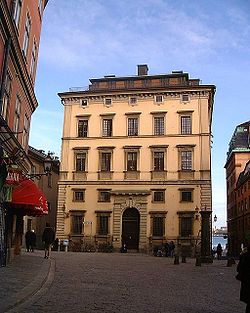
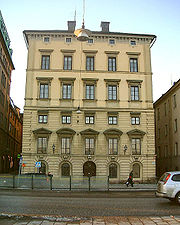
Gamla stan
Gamla stan , until 1980 officially Staden mellan broarna , is the old town of Stockholm, Sweden. Gamla stan consists primarily of the island Stadsholmen. The surrounding islets Riddarholmen, Helgeandsholmen, and Strömsborg are officially part of, but not colloquially included in, Gamla stan...
, the old town of Stockholm
Stockholm
Stockholm is the capital and the largest city of Sweden and constitutes the most populated urban area in Scandinavia. Stockholm is the most populous city in Sweden, with a population of 851,155 in the municipality , 1.37 million in the urban area , and around 2.1 million in the metropolitan area...
, Sweden
Sweden
Sweden , officially the Kingdom of Sweden , is a Nordic country on the Scandinavian Peninsula in Northern Europe. Sweden borders with Norway and Finland and is connected to Denmark by a bridge-tunnel across the Öresund....
, together with Norra Bankohuset the location of the Bank of Sweden until 1906. It is facing the square Järntorget
Järntorget (Stockholm)
Järntorget is a small public square in Gamla stan, the old town in central Stockholm, Sweden. Located in the southernmost corner of the old town, the square connects the thoroughfares Västerlånggatan and Österlånggatan, while the two alleys, Södra Bankogränd and Norra Bankogränd, stretches east...
on its west side and Skeppsbron
Skeppsbron
Skeppsbron is both a street and a quay in Gamla stan, the old town of Stockholm, capital of Sweden, stretching from the bridge Strömbron in front of the Royal Palace southward to Slussen....
on its east, while two alleys passes north and south of it, Norra Bankogränd
Norra Bankogränd
Norra Bankogränd is an alley in Gamla stan, the old town of Stockholm, Sweden. Connecting Skeppsbron to Österlånggatan and Järntorget, it forms a parallel street to Tullgränd and Södra Bankogränd....
and Södra Bankogränd
Södra Bankogränd
Södra Bankogränd is an alley in Gamla stan, the old town of Stockholm, Sweden: Connecting Skeppsbron to Österlånggatan and Järntorget, it forms a parallel street to Norra Bankogränd and Norra Dryckesgränd....
.
The western quarter of the building including the façade, built in 1675-1682, was designed by Nicodemus Tessin the Elder
Nicodemus Tessin the Elder
Nicodemus Tessin the Elder was an important Swedish architect.-Biography:Nicodemus Tessin was born in Stralsund in Pomerania and came to Sweden as a young man. There he met and worked with the architect Simon de la Vallée...
(1615–1684); the western court and its two wings were built in 1694-1712 under the son of the latter, Nicodemus Tessin the Younger
Nicodemus Tessin the Younger
Count Nicodemus Tessin the Younger was a Swedish Baroque architect, city planner, and administrator.The son of Nicodemus Tessin the Elder and the father of Carl Gustaf Tessin, Tessin the Younger was the middle-most generation of the brief Tessin dynasty, which have had a lasting influence on...
(1654–1728); while the eastern half and façade were designed by Carl Hårleman
Carl Hårleman
Baron Carl Hårleman was a Swedish architect.Hårleman was born in Stockholm, son of the garden architect and head of the royal parks and gardens Johan Hårleman, who hade been ennobled in 1698, and began his architectural training under Göran Josua Adelcrantz...
(1700–1753) and built during the period 1733-1737.
Coherently designed as elongated block-size palace, Södra Bankohuset unites the prestigious line-up along Skeppsbron with the narrow urban conglomeration of the old town. The plain architrave
Architrave
An architrave is the lintel or beam that rests on the capitals of the columns. It is an architectural element in Classical architecture.-Classical architecture:...
s and original Renaissance
Renaissance architecture
Renaissance architecture is the architecture of the period between the early 15th and early 17th centuries in different regions of Europe, demonstrating a conscious revival and development of certain elements of ancient Greek and Roman thought and material culture. Stylistically, Renaissance...
design of the western façade is repeated around the building, and is in the eastern façade supplemented with pediment
Pediment
A pediment is a classical architectural element consisting of the triangular section found above the horizontal structure , typically supported by columns. The gable end of the pediment is surrounded by the cornice moulding...
s, channelled rustication
Rustication (architecture)
thumb|upright|Two different styles of rustication in the [[Palazzo Medici-Riccardi]] in [[Florence]].In classical architecture rustication is an architectural feature that contrasts in texture with the smoothly finished, squared block masonry surfaces called ashlar...
up to the mezzanine
Mezzanine (architecture)
In architecture, a mezzanine or entresol is an intermediate floor between main floors of a building, and therefore typically not counted among the overall floors of a building. Often, a mezzanine is low-ceilinged and projects in the form of a balcony. The term is also used for the lowest balcony in...
, and a rocaille over the entrance pouring out bank notes and coins. The western portal is a quotation of Vignola's
Giacomo Barozzi da Vignola
Giacomo Barozzi da Vignola was one of the great Italian architects of 16th century Mannerism. His two great masterpieces are the Villa Farnese at Caprarola and the Jesuits' Church of the Gesù in Rome...
portal at Villa Farnese
Villa Farnese
The Villa Farnese, also known as Villa Caprarola, is a mansion in the town of Caprarola in the province of Viterbo, Northern Lazio, Italy, approximately 50 kilometres north-west of Rome...
in Caprarola
Caprarola
Caprarola is a town and comune in the province of Viterbo, in the Lazio region of central Italy. The village is situated in a range of volcanic hills known as the Cimini Mounts....
.
History

The Scales House and The Iron Square
From at least the reign of King Magnus ErikssonMagnus IV of Sweden
Magnus Eriksson as Magnus IV was king of Sweden , including Finland, as Magnus VII King of Norway , including Iceland and Greenland, and also ruled Scania . He has also vindictively been called Magnus Smek...
(1316–1377) the official scales of the city meant an important source of income for the city and the king alike. From no later than the 15th century the scales were located at the city's southern square, and subsequently the building housing the scales and preceding the present building was called Våghuset ("Scales House" or Weigh house). As the city introduced more scales, probably in 1637, the southern scales were being used exclusively for the weighing of iron, copper, and other metals, which eventually gave the square next to it its present name Järntorget
Järntorget (Stockholm)
Järntorget is a small public square in Gamla stan, the old town in central Stockholm, Sweden. Located in the southernmost corner of the old town, the square connects the thoroughfares Västerlånggatan and Österlånggatan, while the two alleys, Södra Bankogränd and Norra Bankogränd, stretches east...
("The Iron Square"). Given a depiction in an etching from 1660, and the location of the water front and city wall at the time, the Scales House is likely to have been located somewhere in the middle of the present site. It is depicted as having gables facing west and east with rows of six windows facing the alleys; probably occupying an area of 18×18 metres.
During the second half of the 15th century, Stockholm was being transformed into a city built in stone and the Scales House present in Vädersolstavlan
Vädersolstavlan
is an oil-on-panel painting depicting a halo display, an atmospheric optical phenomenon, observed over Stockholm on April 20, 1535. It is named after the sun dogs appearing on the upper right part of the painting...
, a painting depicting an event in 1535 and the oldest known colour image of the city, was probably built in the 1460s, an assumption confirmed both by historical records and dendrochronological
Dendrochronology
Dendrochronology or tree-ring dating is the scientific method of dating based on the analysis of patterns of tree-rings. Dendrochronology can date the time at which tree rings were formed, in many types of wood, to the exact calendar year...
samples. It is depicted as a one-storey brick building with a stepped gable and white blind windows, a crane hanging over the round arched portal facing the square. A clock was added in the mid-16th century together with a shed for foreign merchants to keep their goods. As two stories were added to the Scales House in 1596-1603, the shed was enlarged into a warehouse and the entire structure transformed into a Renaissance
Renaissance
The Renaissance was a cultural movement that spanned roughly the 14th to the 17th century, beginning in Italy in the Late Middle Ages and later spreading to the rest of Europe. The term is also used more loosely to refer to the historical era, but since the changes of the Renaissance were not...
building furnished with an elaborated stone portal, horizontal sandstone
Sandstone
Sandstone is a sedimentary rock composed mainly of sand-sized minerals or rock grains.Most sandstone is composed of quartz and/or feldspar because these are the most common minerals in the Earth's crust. Like sand, sandstone may be any colour, but the most common colours are tan, brown, yellow,...
fillet
Fillet
Fillet may refer to:*Fillet , a headband*Fillet , a piece of meat*Fillet , the filling of an interior corner*Annulet , part of a column capital...
s, volutes and finial
Finial
The finial is an architectural device, typically carved in stone and employed decoratively to emphasize the apex of a gable or any of various distinctive ornaments at the top, end, or corner of a building or structure. Smaller finials can be used as a decorative ornament on the ends of curtain rods...
s, and a ridge turret
Ridge turret
A ridge turret is a turret build on the peak of a roof....
covered in copper. Stone tables on the front gable were painted in blue and furnished with gilded crowns and the inscription "1603". One of these can still be found in the entrance facing Skeppsbron.
Tessin the Elder
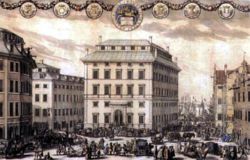
Nicodemus Tessin the Elder
Nicodemus Tessin the Elder was an important Swedish architect.-Biography:Nicodemus Tessin was born in Stralsund in Pomerania and came to Sweden as a young man. There he met and worked with the architect Simon de la Vallée...
the following year were however interrupted by financial difficulties.
Now, the Bank of Sweden was established in 1668 as an institution not controlled by the king but by the Diet of the Estates
Riksdag of the Estates
The Riksdag of the Estates , was the name used for the Estates of the Swedish realm when they were assembled. Until its dissolution in 1866, the institution was the highest authority in Sweden next to the King...
, Riksens Ständer bank, thus securing strength and reliability - Hinc robur et securitas. When a bank building on the present site was requested by the bank authority in 1675, the city accepted the responsibility to ensure its accomplishment, thus initiating one of the first bank buildings in Northern Europe. In 1676, Tessin the Elder presented a scaled-down version of his original stock exchange design; restricting the new structure to the working site between the old Scale House and the square. Tessin the Elder was old and weak in health however, why his two sons, Nicodemus Tessin the Younger
Nicodemus Tessin the Younger
Count Nicodemus Tessin the Younger was a Swedish Baroque architect, city planner, and administrator.The son of Nicodemus Tessin the Elder and the father of Carl Gustaf Tessin, Tessin the Younger was the middle-most generation of the brief Tessin dynasty, which have had a lasting influence on...
and Abraham Winandt, had a considerable influence on the design. As both returned from theirs Grand Tour
Grand Tour
The Grand Tour was the traditional trip of Europe undertaken by mainly upper-class European young men of means. The custom flourished from about 1660 until the advent of large-scale rail transit in the 1840s, and was associated with a standard itinerary. It served as an educational rite of passage...
s at this time, they left their impressions from Italy clearly readable in the building.
The façade is made of bright fair-faced plaster and sandstone supporting a Swedish manor-house roof (a Mansard-like roof
Mansard roof
A mansard or mansard roof is a four-sided gambrel-style hip roof characterized by two slopes on each of its sides with the lower slope at a steeper angle than the upper that is punctured by dormer windows. The roof creates an additional floor of habitable space, such as a garret...
) with an 'Italian' mezzanine. This 'Roman Renaissance
Italian Renaissance
The Italian Renaissance began the opening phase of the Renaissance, a period of great cultural change and achievement in Europe that spanned the period from the end of the 13th century to about 1600, marking the transition between Medieval and Early Modern Europe...
' composition originating from France and Italy, depending on abstract geometry with bricks hidden by plaster, was to become the predominant style in the architecture of Stockholm until the 1870s. The central axis symmetrically passing through the vaulted and richly elaborated lobby, dissolving the contrast between interior and exterior, is clearly inspired by Andrea Palladio
Andrea Palladio
Andrea Palladio was an architect active in the Republic of Venice. Palladio, influenced by Roman and Greek architecture, primarily by Vitruvius, is widely considered the most influential individual in the history of Western architecture...
, the stair wells being very close to Palladio's both in construction and dimensions. Over and under the two 3,5 metres tall main floors are two mezzanine used for storage, a composition topped by an elaborated roof cornice.
The work force for the project had to be brought in from Central Europe; the master builder
Master Builder
Master Builder can refer to:* Master builder, also "master mason", a central figure leading construction projects in pre-modern times .* The Master Builder, a play by Henrik Ibsen....
Hans Buchegger from Switzerland bringing a number of German journeymen
Journeyman
A journeyman is someone who completed an apprenticeship and was fully educated in a trade or craft, but not yet a master. To become a master, a journeyman had to submit a master work piece to a guild for evaluation and be admitted to the guild as a master....
with him. The foundation works were started in 1676 and the roof was covered with copper three years later. Stonemason Anders Brokamp, originally from Bremen
Bremen
The City Municipality of Bremen is a Hanseatic city in northwestern Germany. A commercial and industrial city with a major port on the river Weser, Bremen is part of the Bremen-Oldenburg metropolitan area . Bremen is the second most populous city in North Germany and tenth in Germany.Bremen is...
, was employed for both exterior and interior decorations, while the stuccoer Simon Necleus and the carpenter
Carpenter
A carpenter is a skilled craftsperson who works with timber to construct, install and maintain buildings, furniture, and other objects. The work, known as carpentry, may involve manual labor and work outdoors....
Daniel Heinssler were paid in 1679. After tiled stoves had been installed and the paving in front of the building were finished the following year, the building was finally inhabitated in 1680.
In the board's assembly room, centred on a six metres long desk, was a ceiling painted in grisaille
Grisaille
Grisaille is a term for painting executed entirely in monochrome or near-monochrome, usually in shades of grey. It is particularly used in large decorative schemes in imitation of sculpture. Many grisailles in fact include a slightly wider colour range, like the Andrea del Sarto fresco...
stucco
Stucco
Stucco or render is a material made of an aggregate, a binder, and water. Stucco is applied wet and hardens to a very dense solid. It is used as decorative coating for walls and ceilings and as a sculptural and artistic material in architecture...
-imitations, walls covered with woven fabrics displaying a forest landscape, and doors and windows furnished with green broadcloths and curtains. The remaining spaces were left quite more modest, with white-washed walls and board floors and ceilings in the rooms, and limestone floors in the corridors and stairwell.
Tessin the Younger
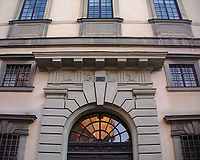
Nicodemus Tessin the Younger
Count Nicodemus Tessin the Younger was a Swedish Baroque architect, city planner, and administrator.The son of Nicodemus Tessin the Elder and the father of Carl Gustaf Tessin, Tessin the Younger was the middle-most generation of the brief Tessin dynasty, which have had a lasting influence on...
, now having taken over the roll as the city architect, to propose a design for an enlargement of the bank. The latter exhorted the bank to produce a programme however, a request the bank would prove to have great difficulties in fulfilling, instead evasivingely describing the project in general terms. The fear of fire destroying valuable documents resulted in a request for a thrust water system including lead tubes in the walls, e.g. a fire sprinkler system, and, more down-to-earth, the faulty communications within the overcrowded building in a request for a bigger stair well.
Nothing much happened before 1708, except for endless discussions over the serviceability and aesthetical benefit of various roof designs, some representatives insisted focusing on the former while others wanted to entrust Tessin with the latter. The architect finally won the dispute and produced a design with the two wings adapted to his fathers building with roofs leaning towards the court. Together with the old vestibule, the new court formed a sequence of spaces decorated with doric
Doric order
The Doric order was one of the three orders or organizational systems of ancient Greek or classical architecture; the other two canonical orders were the Ionic and the Corinthian.-History:...
pilaster
Pilaster
A pilaster is a slightly-projecting column built into or applied to the face of a wall. Most commonly flattened or rectangular in form, pilasters can also take a half-round form or the shape of any type of column, including tortile....
s and moulding
Molding (decorative)
Molding or moulding is a strip of material with various profiles used to cover transitions between surfaces or for decoration. It is traditionally made from solid milled wood or plaster but may be made from plastic or reformed wood...
s. Some Baroque
Baroque
The Baroque is a period and the style that used exaggerated motion and clear, easily interpreted detail to produce drama, tension, exuberance, and grandeur in sculpture, painting, literature, dance, and music...
interior fittings from this time is still present in the building, including classical corner mouldings, fire resistant doors with six double fillings, and separate windows with original hinges, colour, and glaziers lead casements.
Hårleman
Following the endless wars and the death of King Charles XIICharles XII of Sweden
Charles XII also Carl of Sweden, , Latinized to Carolus Rex, Turkish: Demirbaş Şarl, also known as Charles the Habitué was the King of the Swedish Empire from 1697 to 1718...
(1682–1718) came the so called Age of Liberty (1718–1772), a period of recovery during which discussions to extend the bank further east appeared increasingly feasible. In 1730 the bank finally appointed the task to the court intendant Carl Hårleman
Carl Hårleman
Baron Carl Hårleman was a Swedish architect.Hårleman was born in Stockholm, son of the garden architect and head of the royal parks and gardens Johan Hårleman, who hade been ennobled in 1698, and began his architectural training under Göran Josua Adelcrantz...
, at this time busy working on the construction of the Stockholm Palace
Stockholm Palace
The Stockholm Palace is the official residence and major royal palace of the Swedish monarch. . Stockholm Palace is located on Stadsholmen , in Gamla Stan in the capital, Stockholm...
. While the plans were being further worked out 1732-1737, the choice of architect was also being questioned, some arguing Hårleman was to busy for the project and promoting Adelcrantz
Carl Fredrik Adelcrantz
Carl Fredrik Adelcrantz was a Swedish architect and civil servant. Adelcrantz's style developed from a rococo influenced by Carl Hårleman, the leading architect in Sweden in the early years of his career, to a classical idiom influenced by the stylistic developments in France in the mid-to-late...
or Carlberg instead, apprehensions which would however prove unjustified.
As the warehouse was pulled down and the piling started in 1734, the entire eastward extension of the building site, and thus the present extension of the building was settled at 92 ell
Ell
An ell , is a unit of measurement, approximating the length of a man's arm.Several national forms existed, with different lengths, includingthe Scottish ell ,the Flemish ell ,the French ell...
s (approx. 54,5 metres). Exactly where the work of Tessin the Younger ended have been disputed, but as Hårleman paid close attention to the original intentions of both his predecessors, the design is unison throughout the entire building. For the eastern façade however, Hårleman chose a more elaborated Italian Renaissance scheme, using alternatingly arched and triangular window lintels for the piano nobile
Piano nobile
The piano nobile is the principal floor of a large house, usually built in one of the styles of classical renaissance architecture...
, and channelled rustication
Rustication (architecture)
thumb|upright|Two different styles of rustication in the [[Palazzo Medici-Riccardi]] in [[Florence]].In classical architecture rustication is an architectural feature that contrasts in texture with the smoothly finished, squared block masonry surfaces called ashlar...
up to the first mezzanine.
The Rococo
Rococo
Rococo , also referred to as "Late Baroque", is an 18th-century style which developed as Baroque artists gave up their symmetry and became increasingly ornate, florid, and playful...
interior from this period is well preserved, especially the corridors and stair wells with their limestone floors, forged railings, and sheet metal
Sheet metal
Sheet metal is simply metal formed into thin and flat pieces. It is one of the fundamental forms used in metalworking, and can be cut and bent into a variety of different shapes. Countless everyday objects are constructed of the material...
doors, adding an automatic door closer in the attic leading to what used to be the privy. Rococo doors and other details, especially in the lavish session room, are both much elaborated and well preserved.
Adelcrantz
The stair well by Tessin the Younger was rebuilt during the 1780s after a design by Carl Fredrik AdelcrantzCarl Fredrik Adelcrantz
Carl Fredrik Adelcrantz was a Swedish architect and civil servant. Adelcrantz's style developed from a rococo influenced by Carl Hårleman, the leading architect in Sweden in the early years of his career, to a classical idiom influenced by the stylistic developments in France in the mid-to-late...
(1716–1796), the plans resulting from the project being the oldest preserved. At the same time additional basement walls were added, probably to adapt to the weight from the printing presses.
During the 19th and 20th centuries, minor details have been added to the historical setting, including neoclassical and empiricism
Empiricism
Empiricism is a theory of knowledge that asserts that knowledge comes only or primarily via sensory experience. One of several views of epistemology, the study of human knowledge, along with rationalism, idealism and historicism, empiricism emphasizes the role of experience and evidence,...
interior fittings. The bank was relocated to Helgeandsholmen
Helgeandsholmen
Helgeandsholmen is a small island in central Stockholm, Sweden. It is located north of Stadsholmen, and east of Strömsborg, with which, together with Riddarholmen, it forms Gamla stan, the old town of Stockholm...
in 1905, and other state institutions have been accommodated in the building since. During the 1920s the foundation was reinforced. Since 1935 the building have been classified as a historical monument of national interest, and further archaeological investigations, lately in 2003, are hopefully going to unveil more details about the buildings history.
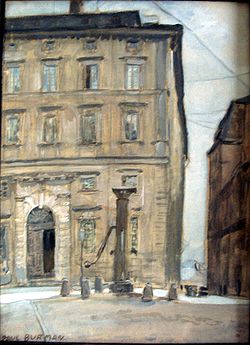
See also
- History of StockholmHistory of StockholmThe history of Stockholm, capital of Sweden, for many centuries coincided with the development of what is today known as Gamla stan, the Stockholm Old Town...
- List of streets and squares in Gamla stan

